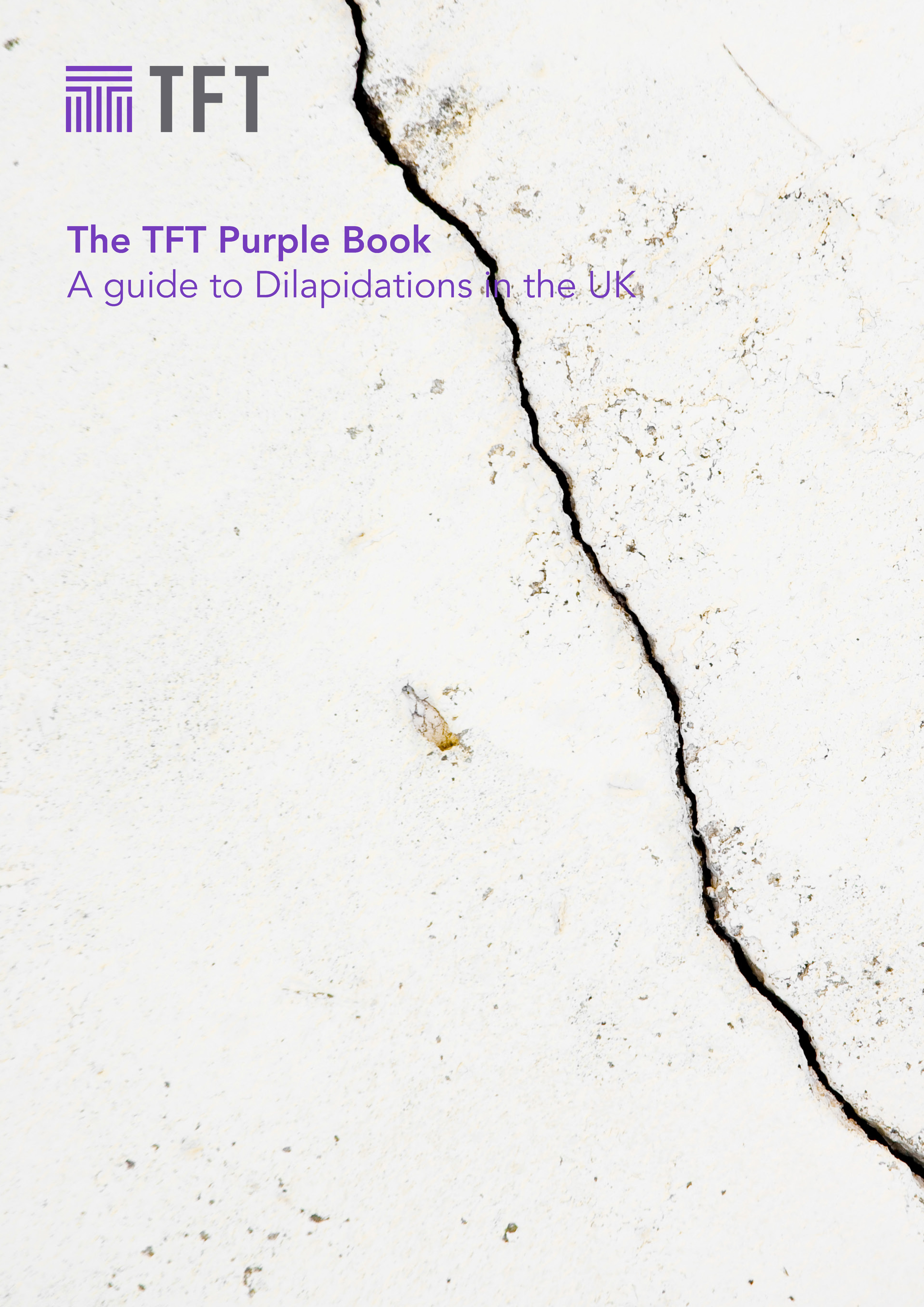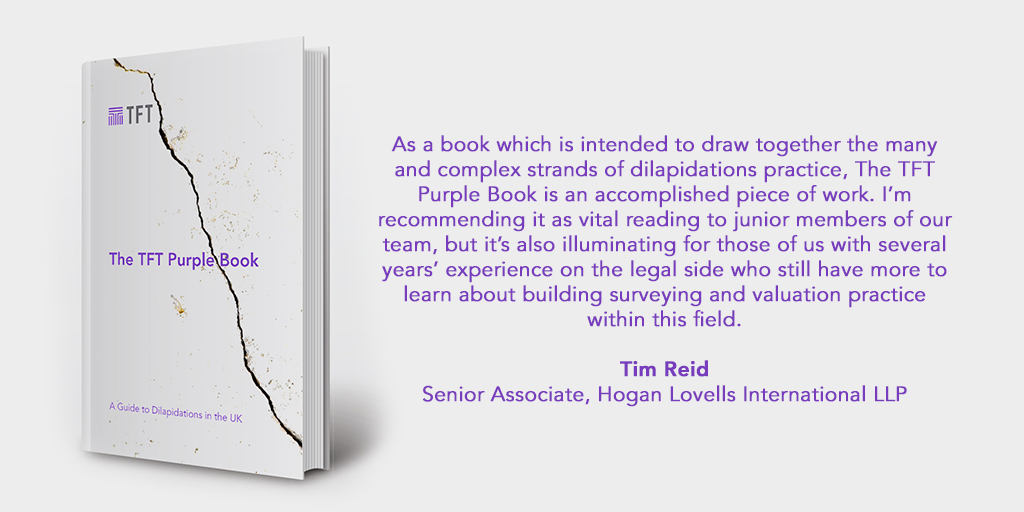Dilapidations Q&A: Your questions, our advice.

Are you a landlord or a tenant looking for dilapidations advice? Start here with our list of commonly asked questions. For more details and advice for specific cases, head over to TFT Dilapidations to get in touch with our expert team who’ll be happy to help!
What is dilapidations?
Dilapidations relates to disrepair and other breaches of non-financial lease covenants during or at the end of a commercial property lease.
What is the role of a dilapidations expert?
Dilapidations experts are specialist surveyors trained to understand buildings, to interpret leases and to understand the associated dilapidations law. They provide sensible advice to landlords or to tenants on the tenant’s breaches at lease end (if any). This informs negotiation of a beneficial settlement of the dilapidations dispute.
In addition to this, some surveyors are appointed as ‘expert witnesses’ or ‘single joint experts’ and specially-trained dilapidations specialists can also act as ‘independent experts’ to resolve dilapidations disputes.
At TFT, we have what we consider to be the most respected dilapidations experts who are available to take on any of these expert roles.
What is dilapidations law?
The law of dilapidations is complex and can be uncertain. There are different legal systems in England and Wales, in Scotland and in Northern Ireland and so dilapidations law and procedure varies throughout the UK. TFT has published an accessible and readable guide to dilapidations called ‘The TFT Purple Book: A Guide to Dilapidations in the UK’.

What is dilapidations supersession?
Supersession is an undefined legal concept which effectively means that a landlord should not claim for the remedy of a tenant’s breach, because the landlord is proposing to do something else to the building which would supersede the need for the tenant to remedy their breach. TFT has developed a two step approach to supersession based on considering (i) mitigation and then (ii) causation.
What is the law relating to dilapidations fixtures and fittings?
The law relating to fixtures and fittings (or chattels/moveable items) is complicated and uncertain. Certain common law rights and/or obligations flow from the classification, which can be varied by contract. Generally speaking, loose items are classified as chattels (or moveable items in Scotland) and fixed items are classified as fixtures, although these presumptions can be varied. Fixtures can then either be classified as ‘landlord’s fixtures’ (‘heritable fixtures’ in Scotland) or ‘tenant’s fixtures’ (‘trade fixtures’ in Scotland). It can be important to understand the classification of items, particularly when dealing with conditional break options.
When should tenants seek dilapidations advice?
Commercial property tenants should always take dilapidations advice before signing a lease. Specialist dilapidations surveyors can assist tenants prior to signing the lease, during the lease term and, most commonly, before and after the end of the lease term when a landlord makes a dilapidations claim against the tenant. It is usual for a dilapidations surveyor to be able to reduce the settlement figure against that originally claimed by the landlord, often substantially.
Do you want advice on a specific issue? Get in touch with TFT dilapidations and dispute resolution expert Jon Rowling.
In dilapidations, what is vacant possession?
There is an implied obligation that a tenant will leave at the end of their lease term, and provide ‘vacant possession’ for the landlord to enjoy. There can often also be a contractual obligation to achieve vacant possession if a tenant wants to break their lease term early. The definition of vacant possession is a legal question but there is an expectation that the tenant will achieve certain conditions, including having moved out and removed certain items from the premises. The law around understanding what has to be removed, what can stay and what should not be removed has become complex in recent years.
What is a dilapidations break clause?
A break clause gives the parties (usually the tenant) the option to end the lease term early. Often certain conditions, including some builders’ works are required to be completed by a tenant before the break date in order for the break option not to be invalid. Specialist dilapidations surveyors can assist tenants by advising what works need to be completed, or assist landlords by advising what the tenant has failed to do. This is a contentious and specialist area of advice.
Feeling a bit overwhelmed by dilapidations terminology? Never fear, we’ve created a dilapidations glossary to help with that. Find it here.
What is dilapidations expert determination and who does it?
This is a form of alternative dispute resolution which leads to a binding determination. It is not governed by statute (as arbitration is), rather by contract law; the two parties and the independent expert have a contract to facilitate the determination. The expert should use his or her own expertise (as well as any information provided by the parties) to come to a binding determination. There is very little scope for appeal. Generally, expert determination is considered to be best suited to specialist commercial disputes, such as dilapidations. At TFT, we can accept appointments to act as the independent expert, or to help parties who are engaged in the process.
What is the dilapidations dispute resolution scheme?
Published by RICS, the Scheme is designed specifically for end of lease commercial dilapidations disputes. The dispute is settled by an independent expert with both parties given the opportunity to provide submissions to the expert.
What is dilapidations reinstatement?
As part of a dilapidations claim, the landlord might require the tenant to reinstate alterations the tenant has made to the property, or to remove the tenant’s fixtures. Often, the landlord is required to serve a notice on the tenant in order to trigger the obligation. An obligation to reinstate can also be found within a licence to alter.
What is the dilapidations protocol?
The Dilapidations Protocol is a document published by the Ministry of Justice, relevant only in England and Wales. It tells the parties within a commercial property dilapidations dispute what the court expects them to have done before getting to court.
Are dilapidations provisions subject to VAT?
Commercial property dilapidations settlements in the UK are damages payments so are not subject to VAT. However, an allowance for VAT can be included within the settlement figure if the landlord will incur VAT and not be able to recover it from HMRC.